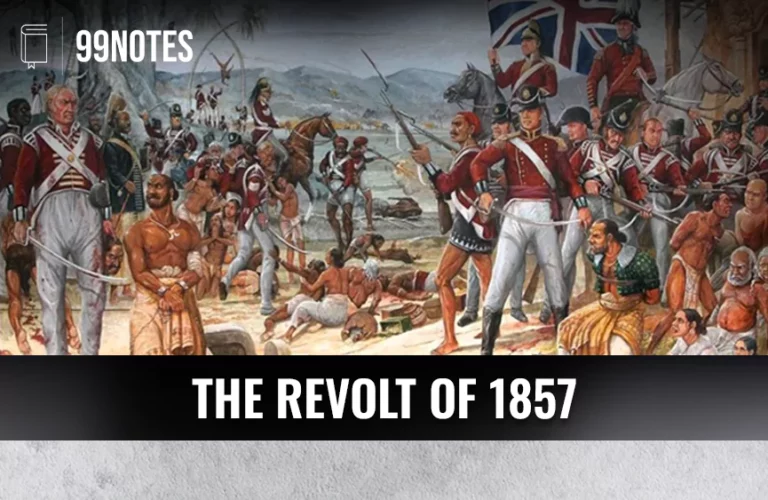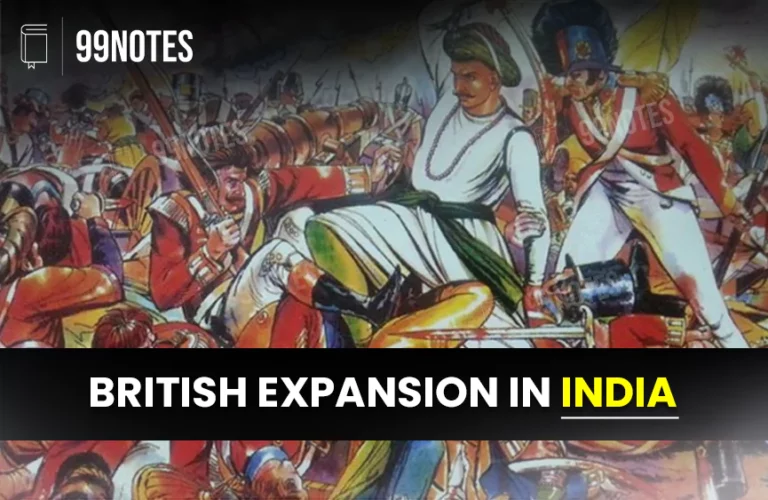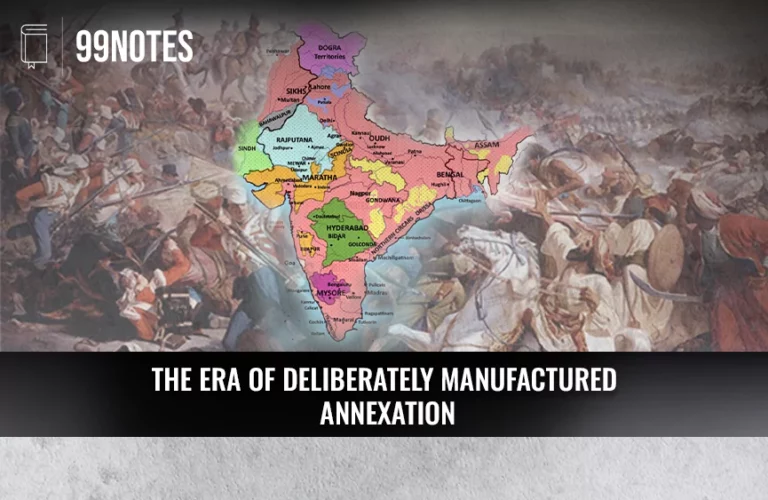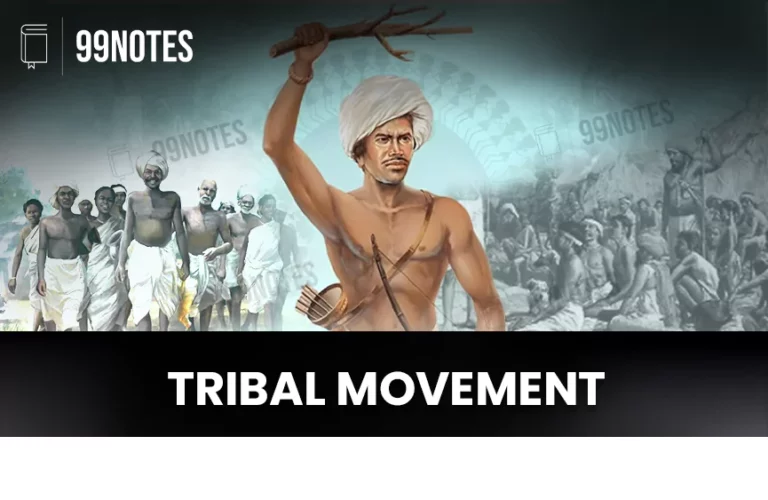Non-Cooperation Movement: Cause, Significance, & Its Impact [UPSC Notes]
Non Cooperation Movement & Khilafat Movement
Intro: The Non Cooperation movement, launched by Mahatma Gandhi in 1920, was a significant phase in the Indian struggle for independence. Aimed at securing Swaraj or self-rule, it called for Indians to not give support for British institutions, boycott foreign goods, and adopt self-reliance. This mass protest against the British rule marked a new strategy of non-violent resistance, mobilizing millions across the country, and laying the groundwork for future civil disobedience campaigns. So lets start the with background.
India During Non Cooperation Movement
The period from 1920-21, in the context of the Indian national movement, is known for mass politics and mass mobilization. Gandhi emerged in the national movement with his idea of Satyagraha, which he had successfully experimented with in South Africa.
During this period, two significant movements emerged: the Khilafat (Caliphate) movement and the non-cooperation movement. The Khilafat movement aimed to restore the Ottoman Caliphate after World War 1, whereas the non-cooperation movement aimed to achieve independence by refusing cooperation with British. Though they had different objectives, both were anti-imperialist and adopted a common action program.
The Non-Cooperation Movement
The Beginning
- In the historic Calcutta special session of 1920, the Congress adopted a programme of giving up titles, a boycott of courts, Councils, and schools along with the boycott of foreign goods (There were some disagreements regarding the boycott of the councils, especially by C R Das)
- In parallel, plans for constructive works were also adopted, like the construction of national schools, resolving matters in Panchayats instead of courts and adopting Khadi.
- Nagpur session of the Congress, December 1920
- Veteran Congress leader C R Das lent his support to the movement.
- Now, the Congress agreed to attain Swaraj through peaceful and legitimate extra-constitutional mass struggle.
- Gandhi claimed that if the path of non-cooperation is followed completely, Swaraj can be achieved within a year.
- Many revolutionary leaders, especially from Bengal, also pledged their support for the movement.
- At this juncture, several leaders like Annie Besant, Mohammad Ali Jinnah and B C Pal parted ways with the Congress as they believed in a constitutional struggle.
![Non-Cooperation Movement: Cause, Significance, &Amp; Its Impact [Upsc Notes] | Updated July 27, 2024 Mahatma Gandhi In A Sabha During Non-Cooperation Movement](https://99notes.in/wp-content/uploads/2024/01/The-Non-Cooperation-Movement.png)
Spread of the Non-Cooperation Movement
Support from the Congress leaders gave a new impetus to the movement. It spread quickly in different parts of India. It can be seen in the following points:
- Within a month, a large number of students left the government schools and joined national schools organised under the leadership of C R Das, Acharya Narendra Dev, Lala Lajpat Rai, Zakir Hussain, Subhash Chandra Bose, etc.
- Although the boycott of the law courts was not as successful, many leading lawyers of the country like CR Das, Motilal Nehru, Saifuddin Kitchlew, C Rajagopalachari, MR Jayakar, Vallabhbhai Patel, Asaf Ali and T Prakasham gave up their practice.
- The boycott of foreign clothes became a hit, and its imports fell by half.
- The next phase of the movement was decided in the Vijayawada session in March 1921. Targets were set for enrolling one crore members, one crore Rupees for the Tilak Swaraj Fund and distribution of Charkhas. Consequently, 50 lakh members were enrolled, and the Tilak Swaraj Fund was oversubscribed.
- In July 1921, Mohammed Ali gave a speech in which he declared that it was ‘religiously unlawful for the Muslims to serve in the British Army’ and they should resign and participate in the movement. He was immediately arrested. Gandhi, in his support, called all men (civilian or soldier) to sever their links with the British army.
- In this situation, the Prince of Wales visited India in November 1921. He was greeted by hartals all over India.
Regional struggles (Link)
-
- Soon, the movement was progressing at local levels; in the Midnapore district of Bengal, a movement was organised against Union Board taxes and a no-tax campaign was organised in Andhra Pradesh.
- In the Awadh region of the United Province, peasant movements gained momentum through the Awadh Kisan movement, Eka Movement and Mappila revolt.
- In Punjab, Sikhs were agitating for Gurudwara reforms.
Last phase of the Non Cooperation movement
-
- In its fourth stage, the protestors and the Government appeared to be in a confrontationist mood. Khilafat leader Hasarat Mohani was in favour of demanding complete independence. The Government started using repression as its official policy.
- In December 1921, the Government came down heavily on the protestors. Volunteer corps organised by the Congress were declared illegal, public meetings were banned, the press was gagged, and most leaders except Gandhi were arrested.
- On 1 February 1922, Gandhi threatened to launch a mass civil disobedience campaign if the Government did not release political prisoners and ease press restrictions.
- However, the movement came to a halt due to the incident at Chauri Chaura.
Chauri Chaura Incident and Aftermath
On 5 February 1922, in Chauri Chaura in Gorakhpur district, police fired on a group of Congress volunteers. In retaliation, the enraged mob set fire to the police station, in which 22 policemen were killed. Gandhi was unhappy with the violent trend in the movement.
- Gandhi immediately withdrew the movement, and it was later ratified by the Congress working committee at Bardoli.
- The committee decided to go for constructive work instead, which included national schools, popularisation of Khadi, campaigns for Hindu-Muslim unity and against untouchability.
- Soon after this, Gandhi was arrested on 10 March 1922 and sentenced to six years in jail.
- Nationalist leaders like C R Das, Motilal Nehru, Jawaharlal Nehru and Subhash Chandra Bose expressed their resentment at the decision to withdraw the movement.
- The Khilafat leaders were also unhappy about the decision. The Khilafat movement also declined due to international factors. Under Mustafa Kemal Pasha, Turkey abolished the Ottoman Sultanate in 1922, and in 1924, the position of Khalifa (Caliphate) itself was abolished.
![Non-Cooperation Movement: Cause, Significance, &Amp; Its Impact [Upsc Notes] | Updated July 27, 2024 Shaheed Smarak Chauri Chaura](https://99notes.in/wp-content/uploads/2024/01/Shaheed-Smarak-Chauri-Chaura-.jpg)
Shaheed Smarak Chauri Chaura (https://gorakhpur.nic.in/tourist-place/shaheed-smarak-chaurichaura/)
Reason for Non Cooperation Movements:
Various events provided a background for these movements as:
1. Hardships due to the 1st world war
- The war increased defence expenditure and wartime expenses, which were compensated by increasing income taxes and customs duties.
- Between 1913 and 1918, prices of daily commodities doubled, causing extreme hardships to the common people.
- The peasantry was under the heavy burden of taxes and rents. In many areas, crops failed, causing an acute shortage of food.
- The soldiers of the First World War brought with them Spanish flu, causing a large number of fatalities. According to the census of 1921, 12-13 people perished due to famines and epidemics.
- The anti-British feeling grew stronger when the British failed to keep their promise of bringing self-governing institutions.
2. Passing of the draconian Rowlatt Act
- The act empowered the Government to imprison any person without trial and conviction in a court of law. This led to widespread outrage against the Government.
- Gandhi decided to launch his first Satyagraha at the all-India level.
3. Jallianwala Bagh massacre
- This particular incident brought the naked brutality of British imperialism into the open.
- Thousands of unarmed peaceful protesters were fired upon without warning, causing the loss of hundreds of lives.
- The whitewashing of the incident by the Hunter committee and the lack of disciplinary action against General Dyer was like rubbing salt in the wound.
4. Common political action by Hindus and Muslims
- The younger Muslim League leadership favoured common political action and active involvement in the nationalist movement.
- Lucknow Pact in 1916 and Rowlatt Satyagraha had brought the Hindus and The Muslims together.
- In this environment emerged the Khilafat movement, which developed into the Non-cooperation movement.
5. Disillusionment with the Mont-ford reforms
- The introduction of another set of reforms through the Government of India Act 1919 further disillusioned the nationalists.
- It failed to satisfy the rising demands for self-government. Congress called the reforms ‘inadequate, unsatisfactory and disappointing’.
6. Khilafat Issue
- In the First World War, Turkey allied with Germany and Austria against Britain.
- Muslims worldwide considered the Sultan of Turkey to be their spiritual leader or Caliph (Khalifa).
- After the war, Britain removed the Khalifa from power; this angered the Muslims in India.
The Khilafat Movement![Non-Cooperation Movement: Cause, Significance, &Amp; Its Impact [Upsc Notes] | Updated July 27, 2024 Ali Brothers](https://99notes.in/wp-content/uploads/2024/01/The-Khilafat-Movement.jpg)
(Ali Brothers)
Background
Indian Muslims started the Khilafat movement for the restoration of the institution of Khalifa. The main demands of the Khilafat leaders were:
- Khalifa’s control should be retained over the Muslim sacred places.
- The Caliph should be left with sufficient territories in territorial adjustments after the war.
The Khilafat Movement
- In early 1919, a Khilafat Committee was set up in Bombay under the leadership of the Ali brothers (Muhammad Ali and Shaukat Ali), Maulana Azad, Ajmal Khan, and Hasrat Mohani.
- Initially, the Khilafat agitations were confined to meetings and petitions, But soon, a militant trend emerged in the movement, which proposed total non-cooperation with the Government and a countrywide protest.
- In February 1920, a joint Hindu-Muslim deputation met the Viceroy regarding the Khilafat grievances, but to no avail.
- In April 1920, Shaukat Ali warned the Government of a Hindu-Muslim joint non-cooperation movement under Mahatma Gandhi if the Government failed to pacify Muslims.
- In May 1920, Turkey was dismembered under the Treaty of Sevres.
- In June 1920, at the Allahabad meeting of the Khilafat Conference, a four-stage non-cooperation cooperation was announced– boycott of titles, of the civil services, of the police and army and finally, non-payment of taxes.
- On 31 August 1920, the Khilafat Committee formally launched the non-cooperation movement.
Views of Gandhi and the Congress on the Khilafat Movement
- While the issue of the Khilafat movement was not directly linked with Indian politics, Gandhi saw it as an opportunity to build Hindu-Muslim unity against the British. He was the president of the All-India Khilafat committee.
- Initially, the Congress, especially Tilak, did not favour allying with Muslim leaders over a religious issue. He was also sceptical of the Satyagraha as an instrument of politics.
- Later, however, Gandhi was able to get approval for starting his Satyagraha on the issues of removal of Khilafat, Punjab wrongs and the establishment of Swaraj.
- The main reasons behind the Congress’s approval were:
-
- Golden opportunity to cement Hindu-Muslim unity.
- The Congress was losing faith in the constitutional struggle, especially after the Jallianwala Bagh massacre and its whitewashing by the Hunter committee.
- The Congress was aware that people were eager to express their discontent.
Why was the Non Cooperation Movement withdrawn?
- Gandhi thought that people had still not fully learnt or understood the method of non-violence. Gandhi knew that the Government could easily suppress a violent movement.
- The movement was gradually turning into a no-rent campaign against Zamindars. However, the Congress leadership was not interested in attacking the legal rights of the Zamindars.
- The Khilafat question was dissipating due to the changing political situation in Turkey.
- The movement was showing signs of fatigue, and the Government was in no mood for negotiations.
People’s response to the movement
People of different classes responded differently to the movement:
Response of the Middle Class
- In the initial stages, the movement’s leadership came from the middle class.
- However, they had some reservations about Gandhi’s program. The response to Gandhi’s movement was very limited in places like Calcutta, Bombay, and Madras, which were centres of elite politicians.
- Their response to the call for resignation from government service, surrendering of titles, etc., was not very encouraging.
- The newcomers in Indian politics, like Rajendra Prasad in Bihar and Sardar Patel in Gujarat, found expression in the non-violent movement, which they found to be a viable political alternative to revolutionary activities. They provided a solid base for the movement.
Response of the Business class on Non Cooperation Movement
- The boycott of foreign clothes and the popularisation of Swadeshi got support from Indian textile manufacturers.
![Non-Cooperation Movement: Cause, Significance, &Amp; Its Impact [Upsc Notes] | Updated July 27, 2024 Response Of The Business Class On Non Cooperation Movement](https://99notes.in/wp-content/uploads/2024/01/Response-of-the-Business-class.jpg)
- However, a section of the business class remained critical of the movement due to fear that the movement could encourage labour unrest in the factories.
Response of Student and women
- The movement got very effective responses from students and women.
- Thousands of students left government schools and joined national schools. They were accommodated into nationalist institutions like Kashi Vidyapeeth, Jamia Milia Islamia, Gujarat Vidyapeeth, etc.
- Women participated in large numbers and actively participated in picketing before shops selling liquor and foreign clothes.
- Women gave up Purdah and sold their jewellery for the Tilak Swaraj fund.
Response of Peasants and workers
- The movement saw massive participation from peasants and workers.
- Their longstanding grievances against the Government were expressed through this movement.
- Against the wishes of the Congress, which did not want to be involved in the class struggle, peasants turned against zamindars and traders in rural areas.
Impact of Non Cooperation Movement
- Relaxed caste rigidities: Gandhi emphasised on removing caste barriers and untouchability. In meetings, processions and jails, people of all castes and communities were involved; this eased caste rigidities and accelerated the pace of social mobility.
- Hindu-Muslim unity: The movement saw remarkable unity between the Hindus and the Muslims. The movement brought young Muslims into the national movement. However, the issue of Khilafat also communalised national politics.
- Economic boycott: The economic boycott of foreign clothes significantly reduced imports from England. Indian textile manufacturers immensely benefited from the boycott of foreign goods. Khadi and handloom cloth production went up.
- Common People: For the first time, the common people became an important part of the mainstream of the national movement. The movement brought self-confidence and self-esteem to the common people; it also removed the fear of repressive colonial rule from the minds of people.
Mont-Ford Reforms 1918 and the Government of India Act, 1919
In the lines of announcements made in Montagu’s statement of 1917 (Link), the Government announced Montagu-Chelmsford reforms in 1918. Based on this report, the Government of India Act 1919 was enacted.
Provisions at the Provincial level
Executive
- The act introduced the concept of dyarchy at the provincial government level.
- Dyarchy means the rule of two, i.e., executive counsellors and popular ministries. The Governor was the executive head of the province.
- Under this division, the subjects were divided into ‘reserved’ and ‘transferred’. The reserved subjects were to be administered by the Governor and members of his executive council. The transferred subjects were to be administered by the Governor acting with ministers.
- The transferred subjects included health, education, local self-government, and agriculture, and the reserved subjects included Police, Justice, land revenue, irrigation, etc.
- The Governor and the executive council member were jointly responsible to the Governor-General of India and the Secretary of State for India. The ministers were appointed by the Governor and were responsible to the legislature, unlike the executive council members.
- The Governor could override the decision of his ministers. In case of failure of constitutional machinery, the Governor could also take over the administration of transferred subjects.
- The Secretary of State and the Governor General could interfere in reserved subjects; however, the scope of interference was limited in the case of transferred subjects.
Legislature
- In provinces, there was a unicameral legislature. It consisted of the Executive Council, elected members and nominated members. These legislatures were expanded, and 70 per cent of the members were to be elected.
- In 1920, the number of electors amounted to 5 per cent of the population.
- Women did not get the right to stand in or even vote in elections. However, the act allowed the provincial councils to determine if women could vote provided they met certain conditions: literacy, possession of property, etc.
- While the report gave unfavourable opinions about the separate electorate, it did not recommend abolition. Rather, it extended it to Sikhs in Punjab, Anglo-Indians, Europeans, and Indian Christians and later, demand by the Justice party for reservations for non-Brahmins was also accepted.
- The legislative council could initiate bills, but the assent of the Governor was required. The Governor could veto the bills and issue ordinances.
- The legislative council could reject the budget, but the Governor could restore it.
Provisions at the Central level
Executive
- The chief executive authority remained vested in the Governor General, who was responsible to the British Parliament through the Secretary of State.
- The representation of Indians in the Executive Council of Indians was increased; out of 6 members, three were to be Indians. They were given ministries of lesser importance like law, labour, health and education. They were not accountable to the legislature.
- Now, the Secretary of State for India was to be paid out of the British exchequer.
Legislature
- The act provided a bicameral legislature at the centre, including a Council of States and a Legislative Assembly. The tenure of the Council of State and the legislative assembly was five years and three years, respectively.
- To demarcate the spheres of the central and the provincial governments, two lists were drawn up: the central list and the provincial list. The residual powers were vested in the Governor General.
- The act also provided for the complete separation of revenue between the centre and provinces.
- It became necessary to obtain the previous sanction of the Governor-General before introducing any bill relating to matters enumerated in the provincial list.
- The powers of the Governor General were extended; now, he could veto the bills and certify any legislation rejected by the legislature to be passed on certain grounds like safety, tranquillity, etc.
- Members could now ask supplementary questions, pass adjournment motions and vote on 25 per cent of the budget.
Limitations
- Very limited franchise; only 5 per cent of the population could vote, and women were kept out.
- At the central level, the Viceroy and his executive council were not responsible to the legislature.
- The distribution of seats among provinces was not based on population but on its importance.
- The system of dyarchy created parallel administration and, hence, was unworkable.
- The provincial ministries had no control over finances and the bureaucrats, causing friction between them.
Reaction
- At a special session in Bombay in 1918, Congress called the reforms “inadequate, unsatisfactory and disappointing”.
- Annie Besant denounced its provision as ‘unworthy to be offered by England or to be accepted by India.’
- Moderates in the Congress were not in favour of rejecting the proposals; hence, they abstained from attending the Bombay session. Surendranath Banerjee founded the Indian National Liberal Federation with leaders like Tejbahadur Sapru, M R Jayakar, etc.
Conclusion
The Non-Cooperation Movement and Khilafat movements were one of the crucial event in India’s fight for independence, highlighting the power of collective non-violent action against colonial rule. Though the movement was suspended in 1922 following the Chauri Chaura incident, its impact resonated through subsequent freedom movements, reinforcing the Indian resolve for self-governance and setting a precedent for civil disobedience worldwide. This movement not only challenged British authority but also fostered a sense of national unity and self-esteem among Indians.

![Non-Cooperation Movement: Cause, Significance, &Amp; Its Impact [Upsc Notes] | Updated July 27, 2024 Everything You Need To Know About Non Cooperation Movement](https://99notes.in/wp-content/uploads/2022/10/be-1-of-these-ad-66349f9d113b4-1024x341.webp)





